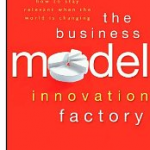Apr26
Kaplan’s Business Model Innovation Factory
Point: Experiment with new business models in a “connected adjacency” before committing to them.
Story: Saul Kaplan, founder of the Business Innovation Factory (BIF), just wrote a new book, The Business Model Innovation Factory. Kaplan shares 15 business model innovation principles, weaving in his personal experience (from Eli Lilly to Accenture to BIF) as well as experiences from numerous presenters at BIF’s Collaborative Innovation Summits. My favorite chapter in the book was “R&D for New Business Models.”
In the chapter, Kaplan describes how to deal the challenges of testing a new business model. Organizations can’t easily jump from an entrenched business model to a new one. There’s too much support for the old model and too many unknowns about the new one. The solution is to test the new business model in what Kaplan calls “connected adjacencies.” A connected adjacency is like a real-world sandbox or living lab. For example, Kaplan details how Accenture changed its business model from being a systems integrator to being a business integrator. Accenture (Andersen Consulting at the time) started to rapidly build a strategic capability alongside its existing systems integration business. As Kaplan writes,
“It was a connected adjacency that was given the autonomy and resources necessary to scale a rapidly-growing strategy practice from scratch – right next to the huge systems integration practice. We were an entrepreneurial business unit within the context of the behemoth. The emergent strategy practice would never have worked if it had to live by the rules of the core business model at the time. If not protected, it would have been swallowed alive by line partners from within the core business model. The new business model needed to be shielded, at least temporarily, within the relative safety of a connected adjacency.”
Part of the success of experimenting in a connected adjacency is letting employees self-select to participate. In Accenture’s case, the company went so far as to hire partners directly from outside the company – something the company had never done before in its “promote from within” philosophy of the past. The connection between the existing business and the innovation sandbox is vital, however, because it lets ideas and experiences be transferred between the two spheres.
In another example, Kaplan describes Babson College’s creation of Babson Global, an entity separate from Babson’s core business model that serves as an R&D platform for creating, prototyping and testing new approaches for teaching entrepreneurship and creating entrepreneurial ecosystems in communities worldwide. The entity is separate from the college but adjacent to it – faculty and staff from the college self-select to participate.
Action:
- Nurture the new business model in a “connected adjacency” — a sandbox, living lab, or side unit of the main business.
- Protect the developing new business model effort from the old model’s metrics and pressures.
- Allow staff to self-select or volunteer for the new model, or hire outsiders so that you have open-minded enthusiasts for the new model rather than adherents to the old.










